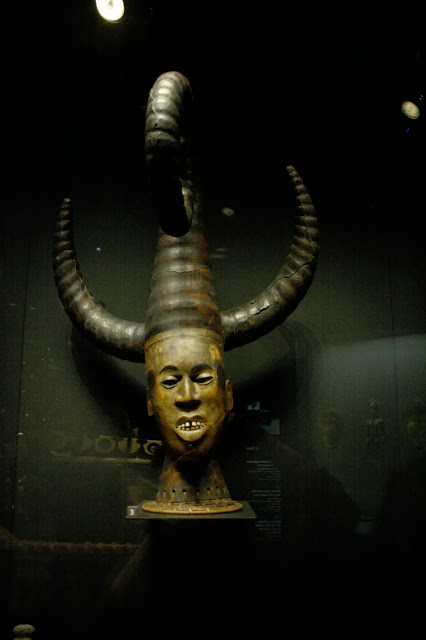Its rich collection dates from thousands of years ago and while you go through every continent you start getting the context as well as some resemblances between cultures which are really far away geographically.
Some of the most captivating pieces, in my opinion where the voodoo objects coming from Benin and its arrival to the Caribbean, specifically Haiti, and how there's a syncretism between voodoo magic, catholicism and popular culture, as a result there is an authentic kitsch mixture, which I could also perceive in costumes of the Bolivian "Diablada" carnival.
Their collection of masks, coming from Africa, and Oceania mainly is unbelievable although I have to admit it seems weird when this objects are decontualixed and put in a museum space, because once you get to watch the videos of the actual rituals and celebrations where they where used, and they become alive it is a whole different thing.
Anyway, there is so much history contained in this amazing building that it could take ages to categorize it, or talk about it all, so I thought I would just share some of my personal highlights.
Maks from Melanesia, Papua New Guinea (20th century)
Masks of funerary dances, Papuasia
Jipae ritual: this masks represent those who have passed away, from the world of the living to the world of the spirits, each Jipae, brings back people who have died since the last Jipae, they spent a day and a night in the village and then they're gone for good.
Phantome figures, Melanesia, Malekula Island
In malekula island, mythical heroes are re-enacted by this pahntomes or shadows in public rituals, sometimes they are used for funerary rituals.
Drawings on rolled paper, India, Bihar, (20th century)
(not sure if this one is called "The Kingdom of Yama" or "The Godess Kali")
Haunting cloths, Afghanistan, Hérat (First half of the 20th century)
Cotton and paint
Fertility dolls, Africa (Ghana, Nigeria, Kenya, South Africa)
This dolls are meant for new mothers, so their children will be healthy and protected.
Masks of The Initiation Society, Ejumba, Senegal.
Masks are brought to life through dance rituals, and they work as mediums between the world of the living and the dead. They are usually made of wood, bone, pigment and fiber and resemble both animals and humans, the whole costume is completed by added hair and dresses.
Representation of sacrifice
Masks from Cross River, Niger, Nigeria (20th century)
Haitian voodoo, Africa and America
Voodoo has it's roots in the west of Africa. During the colonization by the french, hundreds of slaves where taken to the Caribbean Islands, as a result there was a mixture of cults and religions, and they slaves managed to fit their own rituals and beliefs with the catholic religion imposed by the colonizers.
They fought againts slavery, and finally got their independence in 1804 in thecolony of Saint-Domingue.
The main aspect of Haitian voodoo is the representation of Iwa, or the spirits through catholic imagery like a christian saint for example. This objects which history and meaning comes from Benin and the Congo, and then get americanized by the caribbean cultures are definitely charged with a strong energy, they are definitely not meant to be decorative, I find them beautiful but very disturbing.
La Diablada, Oruro, Bolivia
The carnival performed in the mining town of Oruro, manages to mix catholicism and indigenous beliefs. This carnival depicts the struggle between angels and demons, where Lucifer is followed by a pack of male and female demons. On the other side there's angel Michael as the leader of the wholesome pack.
However the devil is represented in various forms, and it also incarnates a positive force, linked to Supay, the god of death and the giver of gifts. This character appears only after the colonization and as all the others it embodies the syncretism between European and indigenous own searches for representation of good and evil.



















